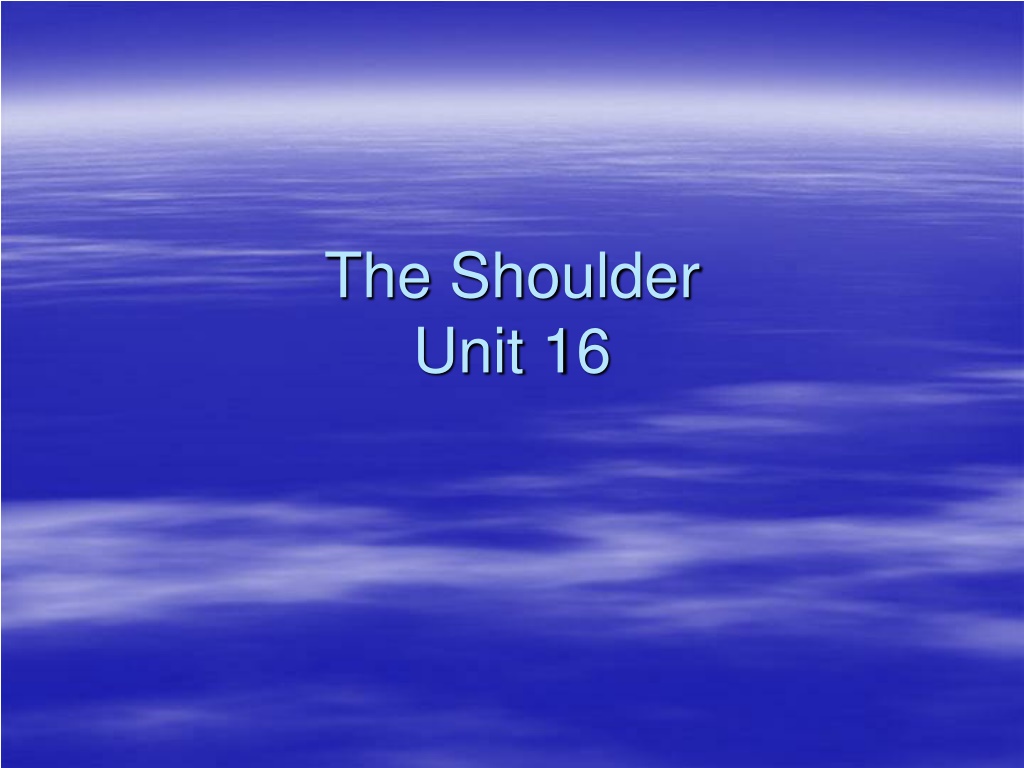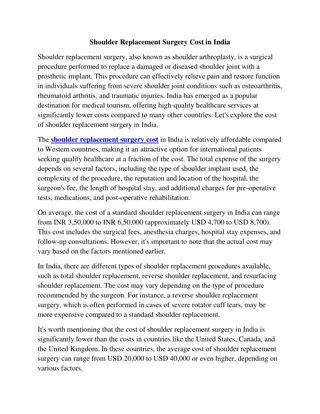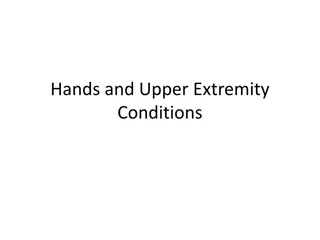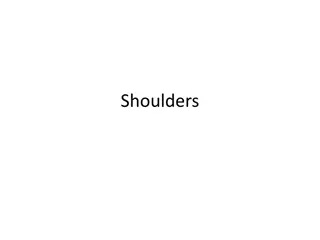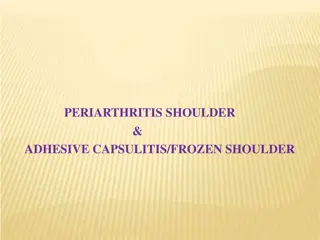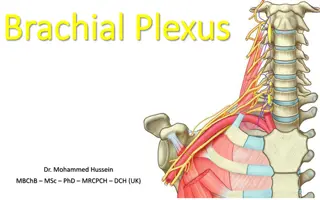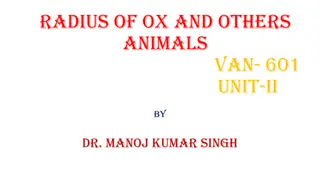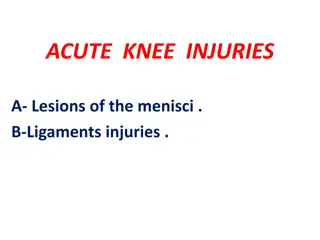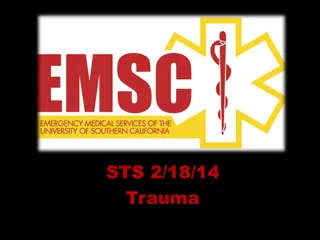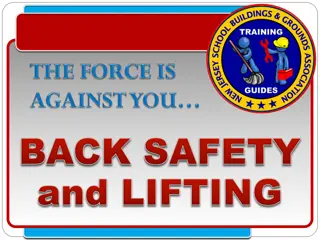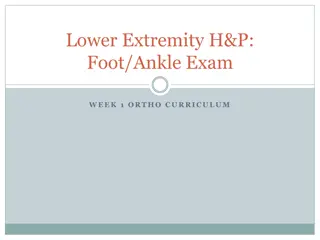Upper Extremity Injuries and Shoulder Physiology
Upper extremities are prone to various injuries in sports, including sprains, strains, dislocations, fractures, and repetitive motion injuries like arthritis and tendonitis. The shoulder complex involves bones, muscles, tendons, ligaments, and articulations. Joints like the sternoclavicular, acromioclavicular, and glenohumeral play crucial roles in shoulder mobility and stability. Muscles such as the anterior deltoid and triceps brachii are responsible for flexion and extension movements. This comprehensive guide provides insights into the anatomy and common injuries of the upper extremities, especially focusing on the shoulder region.
Download Presentation

Please find below an Image/Link to download the presentation.
The content on the website is provided AS IS for your information and personal use only. It may not be sold, licensed, or shared on other websites without obtaining consent from the author.If you encounter any issues during the download, it is possible that the publisher has removed the file from their server.
You are allowed to download the files provided on this website for personal or commercial use, subject to the condition that they are used lawfully. All files are the property of their respective owners.
The content on the website is provided AS IS for your information and personal use only. It may not be sold, licensed, or shared on other websites without obtaining consent from the author.
E N D
Presentation Transcript
The Shoulder Unit 16
Upper Extremity Injuries Upper extremities are vulnerable to a variety of injuries depending on the sport, including: Sprains Strains Dislocations Fractures
Upper Extremity Injuries Upper extremities are vulnerable to a variety of injuries depending on the sport, including: Separations to the thoracic cage, shoulder, arm, and hand Repetitive motion injuries such as arthritis, bursitis, tendonitis
Shoulder Complex Physiology Bones Muscles Tendons Ligaments Articulations
Bones Humerus Scapula Clavicle
THE JOINTS Sternoclavicular joint (SC joint) Sternoclavicular ligament Coracoclavicular joint Coracoclavicular ligament Acromioclavicular joint (AC joint) Acromioclavicular ligament Coracoacromial joint Coracoacromial ligament
Glenohumeral joint Glenohumeral ligaments Scapulothoracic articulation
Muscles in motion FLEXION Anterior deltoid Primary mover Biceps brachii Secondary mover
EXTENSION Posterior deltoid Prim. Mover Triceps brachii Sec. Mover
ABDUCTION Supraspinatus 1st 5-10 degrees Middle deltoid Last 90 degrees Trapezius Assists in movement above 90 degrees
ADDUCTION Latissimus dorsi Pectoralis major
HORIZONTAL FLEXION Pectoralis major Anterior deltoid
HORIZONTAL EXTENSION Posterior deltoid Infraspinatus Teres minor/major Rhomboids Trapezius Stabilizer
CIRCUMDUCTION Basically all muscles of the shoulder
INTERNAL ROTATION Subscapularis Pectoralis major Little help EXTERNAL ROTATION Infraspinatus Teres minor/major
Scapular Elevation Scapular Depression Scapular protraction Scapular retraction ****find muscles that perform these motions
Assessing Shoulder Injuries H O P S
History What is the cause of pain? Mechanism of injury? Previous history? Location, duration and intensity of pain? Creptitus, numbness, distortion in temperature Weakness or fatigue? What provides relief?
Observation Elevation or depression of shoulder tips Position and shape of clavicle Acromion process Biceps and deltoid symmetry Postural assessment (kyphosis, lordosis, shoulders) Position of head and arms Scapular elevation and symmetry Scapular protraction or winging Muscle symmetry Scapulohumeral rhythm
Palpation Bony structure palpation should occur bilaterally and simultaneously if possible Palpate soft tissue structures for point tenderness, swelling, spasms, lumps, guarding or trigger points Be sure to palpate anteriorly and posteriorly
Special Tests ROM test for external rotation of the shoulder ROM test for internal rotation of the shoulder Specific ROM tests for the shoulder including abduction, adduction, flexion, extension, horizontal adduction, horizontal abduction
Manual muscle tests for the shoulder External rotation strength tests Internal rotation strength test for the shoulder Extension strength test for the shoulder Flexion strength test for the shoulder Abduction and adduction strength tests for the shoulder Empty can test
Apprehension test (Crank test) Apprehension test used for anterior glenohumeral instability This motion should not be forced
Test for Shoulder Impingement Neer s test and Hawkins-Kennedy test for impingement used to assess impingement of soft tissue structures Positive test is indicated by pain and grimace
Test for Supraspinatus Weakness Empty Can Test 90 degrees of shoulder flexion, internal rotation and 30 degrees of horizontal abduction Downward pressure is applied Weakness and pain are assessed bilaterally
Types of Shoulder Injuries Fractures Clavicle, humerus, scapula Cause: fall on outstretched arm, direct blow S/S: pain, deformity, decreased ROM, swelling Perform percussion test, compression test
Treatment Sling/splint PRICE Physcian/EMS Follow orders Prevention: Instruct how to fall Proper equipment
Dislocations and subluxations AC, SC, GH jts Cause: head of humerus forced/displaced from glenoid S/S: pop, dead arm, pain, deformity, swelling, loss of ROM/strength
Treatment DO NOT relocated PRICE Check circulation/sensation Physician / x-rays Follow orders Prevention Strengthen jt Proper equipment Falling
Anterior Posterior
Shoulder dislocation-rugby Dwayne Wade http://www.youtube.com/watch?v=09ZZbJze KUA
Contusions Cause: direct blow/bony area or muscles S/S: pain, decreased ROM, r/o other injuries Treatment: ice, padding, rehab, flexibility Prevention: proper equipment, mechanics Myositis ossificans
Sprains Cause: over stretch/tear ligament, capsule What motions/events would cause this? S/S: pt tender, weak, swelling, instability, possible deformity, decreased ROM Treatment PRICE Physician, follow orders Rehab Prevention Proper equipment/technique Strengthening/stretching Inspect playing areas Taping/bracing
Sternoclavicular Sprain Cause of Injury Indirect force, blunt trauma (may cause displacement) Signs of Injury Grade 1 - pain and slight disability Grade 2 - pain, subluxation w/ deformity, swelling and point tenderness and decreased ROM Grade 3 - gross deformity (dislocation), pain, swelling, decreased ROM Possibly life-threatening if dislocates posteriorly Care PRICE, immobilization Immobilize for 3-5 weeks followed by graded reconditioning
